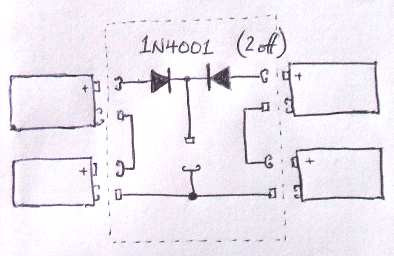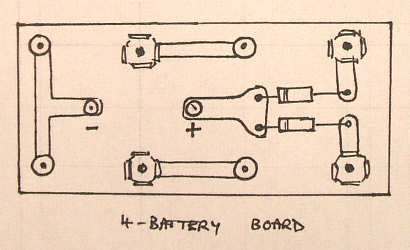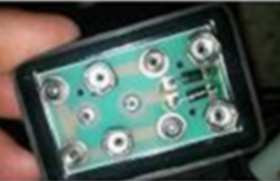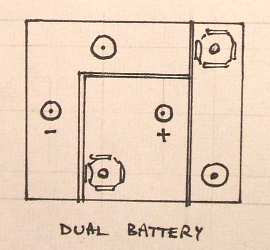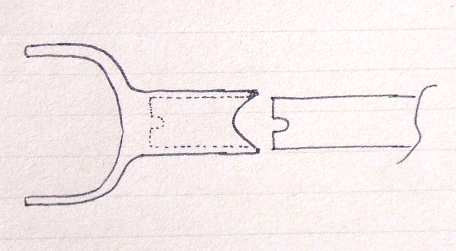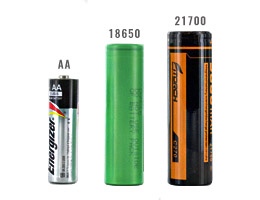-
Posts
565 -
Joined
-
Last visited
Content Type
Forums
Detector Prospector Home
Detector Database
Downloads
Everything posted by PimentoUK
-

Ongoing Equinox Coil Ear Breakage Issue
PimentoUK replied to Bill (S. CA)'s topic in Minelab Equinox Forum
On another forum, someone questioned whether certain manufacturing batches may be more troublesome than others. This made me look closely at my coils, and I see the month/year are moulded into the underside, along with the plastic blend. 11" stock coil (1): date "4" & "18" for April 2018, material "ABS+PC" (polycarbonate/ABS blend). This one had the broken ear. The blame is placed firmly on the previous owner, with worn teardrop washers, plastic-on-plastic wear. 11" stock coil (2): date "2" & "4" for Feb 2018, "ABS+PC" plastic. This one is also secondhand, but was likely less used ( until I got it ... ) and is still going fine with no signs of cracks. It may be educational, (or not) if users post their coil date code in future chat about this issue. -
An interesting product ... I'm in the U.K, so we don't have the same products/brands you US folks do. Is this the wrap you are using? " Glad Press 'n Seal " https://www.amazon.co.uk/Pressn-Multi-Purpose-Sealing-70-Foot/dp/B0041UD2RS You're just pressing it on, I assume, no application of heat needed? Is it like thick 'saran wrap' ? The interweb tells me it has microscopic bubbles on one face, that trap air, which holds it in place? I did find this Baco branded product, a continuous roll, but it's seemingly discontinued. https://www.lakeland.co.uk/17088/Baco-Press-n-Seal From a UK newspaper: "Sadly it is hard to find in the UK - Lakeland has discontinued it while it is sold out elsewhere."
-
Tucked away on the 'Geotech1 dot Com' forum is an incomplete 'Advanced User Guide' , written by Carl Moreland when he worked for Whites. No doubt a few of you are registered there, so here is a direct link: Link: https://www.geotech1.com/forums/showthread.php?26512-V3i-Advanced-User-s-Guide Here are the first 7 chapters for the V3i User's Guide" 1-Intro.pdf 2-QuickStart.pdf 3-BasicSettings.pdf 4-OperatingModes.pdf 5-AudioBasics.pdf 6-CustomAudioDisc.pdf 7-ExpertMenus.pdf
-
Their site isn't quite that unloved, Simon. I found a link in the 'Hobby' section to the: "NEW! 2016 Interactive Catalog" One solution to this 'neglected website' problem is to make the site ridiculously dated, so no-one can tell how old it is. Add some pictures of a moustache-wearing hairy-chested guy in flared jeans detecting the park, or a glamourous Farrah Fawcett lookalike lady in a bikini swinging a big-box unit over the beach.
-
Quote:" In my opinion, what a waste of time, labor and efforts." If their only other option was discontinue it ( due to obsolete parts ) or raise the price significantly ( due to obsolesent parts , having to get custom-manufactured replacements etc ) , they chose the simplest route to keep it going : change what needs to be changed, but keep the majority of it unchanged, as that's why people like it and find it effective.
-

Fisher Gold Bug 2 Gets A Facelift
PimentoUK replied to ☠ Cipher's topic in First Texas - Bounty Hunter, Fisher & Teknetics
An interesting makeover. It makes me wonder if its creation was driven by components becoming obsolete, like the dual-adjust pot? Presumably the main guts are largely unchanged, so it will have the same analogue sound and feel that users like. The headphone socket on one side is 'quirky' , having one on both sides would be better, to cater for oddball lefty folks ( as well as oddball righty ones ). Maybe it's a bit tight for space in there. But it deserves a new name, surely ? Not only to avoid confusion, but to help market it. Goldbug-2D ( D for display ) or -2E ( E for enhanced )? Goldbug-3, perhaps ? -
Good news, now you're all set for arguments with angry Lithuanians, Latvians, Serbians, etc. Don't forget to tell them that you wanting finding golden treasure 10 metre dep. For added fun, make your post in Arabic, they appreciate things like that ... he-he.
-

Early Planchet Or Coin????
PimentoUK replied to dogodog's topic in Metal Detecting For Coins & Relics
These big copper coins were commonly re-used as weights for trade. Re-shaping of the rim of the coin was one thing they often did, and your example seems to have this treatment. Here in the UK, it was done to the George 3rd penny, a big coin that weighed a full one ounce ( Avoirdupois ), I have an example myself, and here's a web-found one: https://picclick.co.uk/rare-cartwheel-penny-turned-in-to-coin-weight-254122836629.html As your one weighs just under half-ounce, it may well be the 1799 halfpenny coin. Here's a modified halfpenny: https://finds.org.uk/database/artefacts/record/id/1029106 -

Another Pinpointer Being Planned At Nokta/Makro
PimentoUK replied to ☠ Cipher's topic in Nokta / Makro Metal Detectors
If a rival has an orange pointer, known as the 'Carrot' , then can't N-M make a cream coloured pointer and name it the 'Parsnip' ? Parsnip Pointer, has a certain flow to it. Or alternatively, name it the 'Neep' , which is colloquial Scottish for turnip. It's not turnip-shaped, clearly, but naming pointers after root vegetables is fashionable currently. The Nokta Neep ... Here's the amusing Scottish Wikipedia page on neeps: https://sco.wikipedia.org/wiki/Neep -
The two coins were 150 metres apart, yet someone decided they belong 'together'. Sure, they could have been dropped together, and one got stuck to the mud of a tractor tyre and taken for a ride up the field. But these details can have implications, affecting whether a find gets officially declared 'Treasure' or not ... with financial / legal procedures / paperwork to deal with.
-

Life Is Good And Some Silver
PimentoUK replied to dogodog's topic in Metal Detecting For Coins & Relics
A great story, and some hunts you'll remember. But as a Brit, I have to correct you on your "KG3" identification. It's actually a William 3rd, it clearly reads GVLIELMVS TERTIVS ( Gulielmus tertius ), and based on the diameter it's a halfpenny. And so that dates it to approx 1700, considerably earlier than the George 3rd coins. Tony Clayton's halfpenny page: http://www.coins-of-the-uk.co.uk/pics/halfp.html#w3- 15 replies
-
- coin detecting
- minelab equinox
-
(and 1 more)
Tagged with:
-

Think I Sold A Simplex For Nokta Makro- The Details
PimentoUK replied to a topic in Nokta / Makro Metal Detectors
A similar topic came up over on the Geotech1 forum. The guy was wanting to know if shallow-ish stainless steel tips from archery arrows would be detectable or not etc. They turned out to be trickier than expected to detect, higher freq machines fared better. Stainless steel is a really poor electrical conductor, which pushes up the target frequency. And long thin items have their target freq determined by the small dimension ( eg. diameter of wire, fastening bolts ) so these tips also favoured high freq machines. A modern Australian-made machine seemed to be capable of finding them OK. -

Any Word On Shipment Of Coiltek 10 X 5 Coils?
PimentoUK replied to relicmeister's topic in Minelab Equinox Forum
I don't think there's much obvious profiteering in that UK dealer's Coiltek pricing. It matches well with the prices for the standard ML coils over here: Example prices : Main ML dealer, Joan Allen: ML 11 inch: 190 GBP ; 267 US Dollars ML 15 inch: 215 GBP ; 303 US Dollars https://joanallen.co.uk/catalogsearch/result/index/?p=1&q=Minelab+Equinox That's what 9% import duty plus 20% Value-added tax ( VAT ) does. ( that's 31%, to save you the maths ) To be honest, I doubt UK folks are clamouring for these coils. Partly because of the price, partly because they don't seem much different to what's already available from ML. -

Vintage Metal Detector Treasure Hunt
PimentoUK replied to Sven1's topic in Compass, D-Tex, Tesoro, Etc.
A little bump to remind anyone trying this 'challenge' that the hunt has officially started. I don't have time to to sort out my old Whites machine, so I'll have to wait until the next such hunt. Maybe a winter hunt next, for those of us who find hot dry summers rather impractical, and softer wet ground more appealing. -

Help With Cz20 Battery Pack Wiring!!!!
PimentoUK replied to DB1000's topic in First Texas - Bounty Hunter, Fisher & Teknetics
The primary purpose of the diodes is to prevent a 'strong' pair of batteries charging-up a 'weak' pair. Primary batteries generally don't care for being recharged ( except in specific ways ) , so diodes block charging current flow. In practice, a strong battery-pair will be drained first, until the voltage starts to match that of the weak pair, then they discharge together in a balanced way, a convenient secondary effect. It would technically be better to use Schottky diodes in this circuit. They behave much the same as regular p-n junction silicon types, but they have a lower forwards voltage drop, typically 0.40V , versus 0.70 V. This would allow the batteries to be discharged that little bit more, before the detector stopped functioning. A suitable common type would be the 1N5818. -

Help With Cz20 Battery Pack Wiring!!!!
PimentoUK replied to DB1000's topic in First Texas - Bounty Hunter, Fisher & Teknetics
Not quite right, Joe, a couple of diodes are missing. I was going to wait for DB1000 to reply before posting up some design details. Seems like I'd better do it now ... it would be useful to other folks, anyway. Update1: Here's the electrical wiring diagram for the 4-cell board. The two diodes are general-purpose 1 Amp silicon diodes, probably 1N4001 , you could substitute other types, including 1N4002 / 1N4003 / 1N4004. If you go with the simpler "dual 9V batteries" arrangement, the diodes are not needed, see diagram attached. Update2: Here's a pic of the battery holder sold on eBay. And a Pic showing the PCB tracking of the board. Simple enough that it could be copied by cutting blank copper-clad GRP board with a sharp knife and a metal ruler. And a pic showing how a simple dual-PP3 board could be made by hand. -

Help With Cz20 Battery Pack Wiring!!!!
PimentoUK replied to DB1000's topic in First Texas - Bounty Hunter, Fisher & Teknetics
"That is expensive. Hoping to just find a writing diagram from someone" It seems you're trying to make one of these devices, yet have no knowledge or skills to do so ? There's already been enough tech info given on here for you to come up with a homebrew solution, even if it is a bit of a 'bodge/kluge/improvised' solution. So to help us out here, what know-how etc do you have? Can you solder ? Can you obtain electronics parts? Do you understand electrical wiring diagrams ? Do you have mechanical engineering skills like sawing/filing/drilling? Are you actually trying to make a faithful close equivalent to the original Fisher part, or do you just want to get the machine working with very minimal financial outlay? -
It's hard, very shiny black resin, sometimes called "potting compound" in the manufacturing industry. And it's tough, so in most circumstances, the coil cover is not needed, saving weight --- important, as the coil is quite big and heavy, giving the overall detector a nose-heavy feel to it.
-

Help With Cz20 Battery Pack Wiring!!!!
PimentoUK replied to DB1000's topic in First Texas - Bounty Hunter, Fisher & Teknetics
Back when the machine was designed, batteries were not so good. So it's quite likely that with good modern batteries, it would work OK with just two series-connected batteries, just shorter run-time. That would simplify a homebrew attempt. Blank copper-clad fibreglass/GRP sheet , the raw material for PCB manufacture, should be available from eBay / electronics surplus dealers / ham radio suppliers. It can be hand cut with a sharp knife to create PCB tracks. The PP3 terminals could be salvaged from dead batteries, or the flying-lead connectors of some obsolete gadget. -
If I was designing that U-shaped clevis part, I would have it fit outside the lower rod. There would be no weak-point where the diameter is reduced, the diameter would be larger hence stronger, and the plastic could be made much thicker, as there's no space constraint. ------- Additional thoughts: Have the end of the clevis tube 'wavy', to spread out stresses on the carbon rod, like seen on lugged bicycle frame joints. Machine notches in the end of the carbon rod, to mate up with protrusions moulded into the clevis. This will help resist twisting forces. Glue the clevis on to the rod in addition to mechanical fixings.
-

Need Help With A Token
PimentoUK replied to Valens Legacy's topic in Metal Detecting For Coins & Relics
A bit of search engine work tells me it's this one: https://en.numista.com/catalogue/exonumia71576.html A nice bit of history, in decent condition. -
Do Predator make custom versions of their tools, like short-handled ones ? Here in the UK, Evolution Products will make 'short' versions of their spade, and their long-handled trowel has a plain shaft so could be shortened by yourself. Probably expensive to import, though. https://www.metaldetectingauction.com/listing/evolution-pro-trowel-with-teeth-long-version/104855
-

3d Printed Battery Pack For Whites Machines
PimentoUK replied to ☠ Cipher's topic in White's Metal Detectors
This impartial, honest, battery test website is well worth a look: https://lygte-info.dk/review/batteries2012/Common18650IndividualTest UK.html Notice how tragically bad the 'xxxxx-Fire' ones, with ridiculous stated capacities perform: https://lygte-info.dk/review/batteries2012/UltraFire CN18650 9800mAh (Yellow) UK.html ... they must be full of air or cardboard or something equally inert. Two informative battery-related websites/forums are the CandlePower one for flashlight junkies, and SecondLifeStorage for recycling enthusiasts and off-grid / prepper types: https://www.candlepowerforums.com/vb/forum.php and https://secondlifestorage.com/index.php -

3d Printed Battery Pack For Whites Machines
PimentoUK replied to ☠ Cipher's topic in White's Metal Detectors
It's a serious problem, there's plenty to trap the unwary. It's easy to take any old cell ( old stock, salvaged from unused equipment, salvaged from USED equipment, small cell fitted into a larger package etc etc ) and then put a pretty new plastic sleeve on it and claim it's 12000 mAh. -

3d Printed Battery Pack For Whites Machines
PimentoUK replied to ☠ Cipher's topic in White's Metal Detectors
"As 18650s improve we are seeing mAh's of 4,000-10,000" I suggest treating any claims of over 4000 mAh as horse excrement, particularly those anonymous no-brand types. If they were from a genuine top brand manufacturer, or re-wrapped ( usually protected ) ones from leading Vape brands or Flashlight/torch makers, then perhaps 4000 is now possible. But the generally-accepted best capacity ones are from Sanyo-Panasonic, coming in at 3500 mAh. Development has been a bit slow on 18650's recently, the electric vehicle makers are favouring 21700 size now, and it may take a while for the tech to make it to 18650 size.


